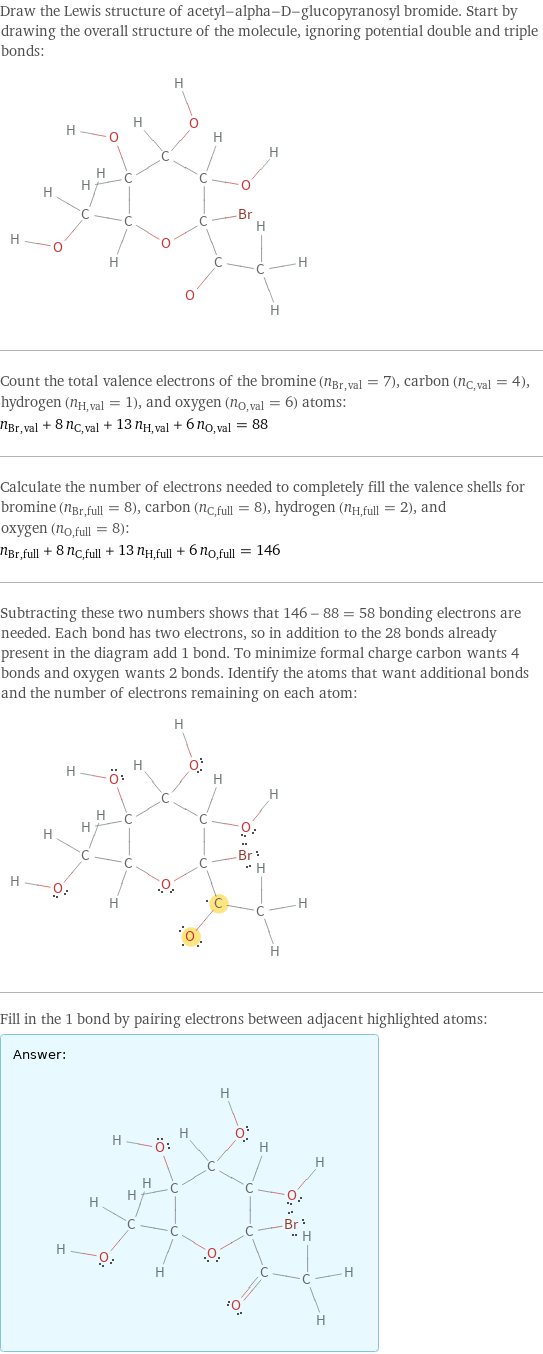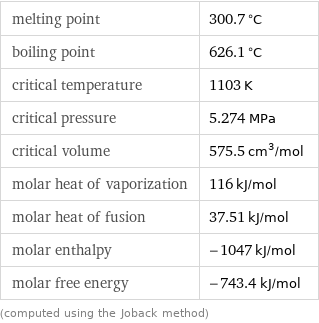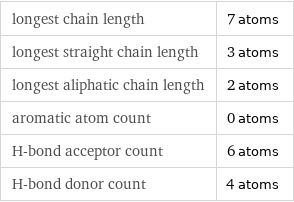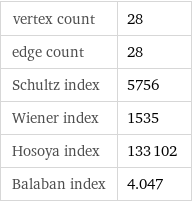Input interpretation

acetyl-alpha-D-glucopyranosyl bromide
Basic properties
![molar mass | 285.1 g/mol formula | C_8H_13BrO_6 empirical formula | C_8O_6Br_H_13 SMILES identifier | CC(=O)[C@]1([C@@H]([C@H]([C@@H]([C@@H](CO)O1)O)O)O)Br InChI identifier | InChI=1/C8H13BrO6/c1-3(11)8(9)7(14)6(13)5(12)4(2-10)15-8/h4-7, 10, 12-14H, 2H2, 1H3/t4-, 5-, 6+, 7-, 8+/m1/s1 InChI key | KHWOJIWDUARZGB-CBQIKETKSA-N](../image_source/acbd3448593b077f61375f21d0e3449e.png)
molar mass | 285.1 g/mol formula | C_8H_13BrO_6 empirical formula | C_8O_6Br_H_13 SMILES identifier | CC(=O)[C@]1([C@@H]([C@H]([C@@H]([C@@H](CO)O1)O)O)O)Br InChI identifier | InChI=1/C8H13BrO6/c1-3(11)8(9)7(14)6(13)5(12)4(2-10)15-8/h4-7, 10, 12-14H, 2H2, 1H3/t4-, 5-, 6+, 7-, 8+/m1/s1 InChI key | KHWOJIWDUARZGB-CBQIKETKSA-N
Lewis structure

Draw the Lewis structure of acetyl-alpha-D-glucopyranosyl bromide. Start by drawing the overall structure of the molecule, ignoring potential double and triple bonds: Count the total valence electrons of the bromine (n_Br, val = 7), carbon (n_C, val = 4), hydrogen (n_H, val = 1), and oxygen (n_O, val = 6) atoms: n_Br, val + 8 n_C, val + 13 n_H, val + 6 n_O, val = 88 Calculate the number of electrons needed to completely fill the valence shells for bromine (n_Br, full = 8), carbon (n_C, full = 8), hydrogen (n_H, full = 2), and oxygen (n_O, full = 8): n_Br, full + 8 n_C, full + 13 n_H, full + 6 n_O, full = 146 Subtracting these two numbers shows that 146 - 88 = 58 bonding electrons are needed. Each bond has two electrons, so in addition to the 28 bonds already present in the diagram add 1 bond. To minimize formal charge carbon wants 4 bonds and oxygen wants 2 bonds. Identify the atoms that want additional bonds and the number of electrons remaining on each atom: Fill in the 1 bond by pairing electrons between adjacent highlighted atoms: Answer: | |
Estimated thermodynamic properties

melting point | 300.7 °C boiling point | 626.1 °C critical temperature | 1103 K critical pressure | 5.274 MPa critical volume | 575.5 cm^3/mol molar heat of vaporization | 116 kJ/mol molar heat of fusion | 37.51 kJ/mol molar enthalpy | -1047 kJ/mol molar free energy | -743.4 kJ/mol (computed using the Joback method)
Units

Quantitative molecular descriptors

longest chain length | 7 atoms longest straight chain length | 3 atoms longest aliphatic chain length | 2 atoms aromatic atom count | 0 atoms H-bond acceptor count | 6 atoms H-bond donor count | 4 atoms
Elemental composition

Find the elemental composition for acetyl-alpha-D-glucopyranosyl bromide in terms of the atom and mass percents: atom percent = N_i/N_atoms × 100% mass percent = (N_im_i)/m × 100% Plan: • Write the chemical formula and gather atomic masses from the periodic table. • Determine values for N_i, m_i, N_atoms and m using these items. • Finally, compute the percents and check the results. Write the chemical formula: C_8H_13BrO_6 Use the chemical formula to count the number of atoms, N_i, for each element and find the total number of atoms, N_atoms, per molecule: | number of atoms C (carbon) | 8 O (oxygen) | 6 Br (bromine) | 1 H (hydrogen) | 13 N_atoms = 8 + 6 + 1 + 13 = 28 Divide each N_i by N_atoms to calculate atom fractions. Then use the property that atom fractions must sum to one to check the work: | number of atoms | atom fraction C (carbon) | 8 | 8/28 O (oxygen) | 6 | 6/28 Br (bromine) | 1 | 1/28 H (hydrogen) | 13 | 13/28 Check: 8/28 + 6/28 + 1/28 + 13/28 = 1 Compute atom percents using the atom fractions: | number of atoms | atom percent C (carbon) | 8 | 8/28 × 100% = 28.6% O (oxygen) | 6 | 6/28 × 100% = 21.4% Br (bromine) | 1 | 1/28 × 100% = 3.57% H (hydrogen) | 13 | 13/28 × 100% = 46.4% Look up the atomic mass, m_i, in unified atomic mass units, u, for each element in the periodic table: | number of atoms | atom percent | atomic mass/u C (carbon) | 8 | 28.6% | 12.011 O (oxygen) | 6 | 21.4% | 15.999 Br (bromine) | 1 | 3.57% | 79.904 H (hydrogen) | 13 | 46.4% | 1.008 Multiply N_i by m_i to compute the mass for each element. Then sum those values to compute the molecular mass, m: | number of atoms | atom percent | atomic mass/u | mass/u C (carbon) | 8 | 28.6% | 12.011 | 8 × 12.011 = 96.088 O (oxygen) | 6 | 21.4% | 15.999 | 6 × 15.999 = 95.994 Br (bromine) | 1 | 3.57% | 79.904 | 1 × 79.904 = 79.904 H (hydrogen) | 13 | 46.4% | 1.008 | 13 × 1.008 = 13.104 m = 96.088 u + 95.994 u + 79.904 u + 13.104 u = 285.090 u Divide the mass for each element by m to calculate mass fractions. Then use the property that mass fractions must sum to one to check the work: | number of atoms | atom percent | mass fraction C (carbon) | 8 | 28.6% | 96.088/285.090 O (oxygen) | 6 | 21.4% | 95.994/285.090 Br (bromine) | 1 | 3.57% | 79.904/285.090 H (hydrogen) | 13 | 46.4% | 13.104/285.090 Check: 96.088/285.090 + 95.994/285.090 + 79.904/285.090 + 13.104/285.090 = 1 Compute mass percents using the mass fractions: Answer: | | | number of atoms | atom percent | mass percent C (carbon) | 8 | 28.6% | 96.088/285.090 × 100% = 33.70% O (oxygen) | 6 | 21.4% | 95.994/285.090 × 100% = 33.67% Br (bromine) | 1 | 3.57% | 79.904/285.090 × 100% = 28.03% H (hydrogen) | 13 | 46.4% | 13.104/285.090 × 100% = 4.596%
Elemental oxidation states

The first step in finding the oxidation states (or oxidation numbers) in acetyl-alpha-D-glucopyranosyl bromide is to draw the structure diagram. Next set every oxidation number equal to the atom's formal charge: In acetyl-alpha-D-glucopyranosyl bromide hydrogen is not bonded to a metal with lower electronegativity, so it will have an oxidation state of +1. Any element bonded to hydrogen gains the bonding electrons, decreasing their oxidation state by 1 for every bond: With hydrogen out of the way, look at the remaining bonds. There are 1 bromine-carbon bond, 7 carbon-oxygen bonds, and 7 carbon-carbon bonds. For each of these bonds, assign the bonding electrons to the most electronegative element. First examine the bromine-carbon bond: element | electronegativity (Pauling scale) | Br | 2.96 | C | 2.55 | | | Since bromine is more electronegative than carbon, the electrons in this bond will go to bromine. Decrease the oxidation number for bromine (by 1 for single bonds, 2 for double bonds, and 3 for triple bonds), and increase the oxidation number for carbon accordingly: Next look at the carbon-oxygen bonds: element | electronegativity (Pauling scale) | C | 2.55 | O | 3.44 | | | Since oxygen is more electronegative than carbon, the electrons in these bonds will go to oxygen: Next look at the carbon-carbon bonds: element | electronegativity (Pauling scale) | C | 2.55 | C | 2.55 | | | Since these elements are the same the bonding electrons are shared equally, and there is no change to the oxidation states: Now summarize the results: Answer: | | oxidation state | element | count -3 | C (carbon) | 1 -2 | O (oxygen) | 6 -1 | Br (bromine) | 1 | C (carbon) | 1 0 | C (carbon) | 4 +1 | H (hydrogen) | 13 +2 | C (carbon) | 2
Orbital hybridization

First draw the structure diagram for acetyl-alpha-D-glucopyranosyl bromide, and for every non-hydrogen atom, count the σ-bonds. Note that double and triple bonds consist of one σ-bond together with one or two π-bonds: Identify those atoms with lone pairs: Find the steric number by adding the lone pair count to the number of σ-bonds: Consult the following chart to determine the hybridization from the steric number: steric number | hybridization 2 | sp 3 | sp^2 4 | sp^3 5 | dsp^3 6 | d^2sp^3 7 | d^3sp^3 Now assign the hybridization for each atom: Answer: | |
Topological indices

vertex count | 28 edge count | 28 Schultz index | 5756 Wiener index | 1535 Hosoya index | 133102 Balaban index | 4.047